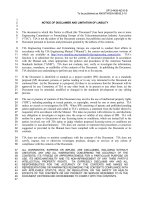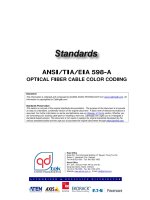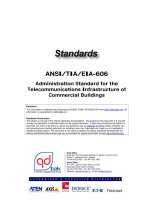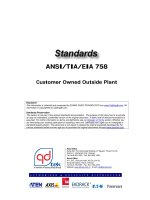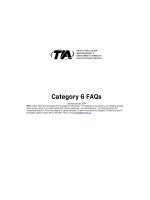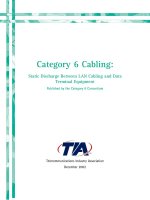Tài liệu Cabling Standard - TSB-155 - IEEE 802.3an for Cat 6A 10GBase-T System - Draft 4.0 pdf
Bạn đang xem bản rút gọn của tài liệu. Xem và tải ngay bản đầy đủ của tài liệu tại đây (248.92 KB, 39 trang )
PN-3-0134 to be published as TSB-155
Draft 4.0
i
1
DRAFT 4.0
2
3
May 1, 2006
4
5
GUIDELINES FOR THE ASSESSMENT AND MITIGATION OF INSTALLED CATEGORY 6 CABLING TO
6
SUPPORT 10GBASE-T
7
NOTICE OF DISCLAIMER AND LIMITATION OF LIABILITY 8
9
The document to which this Notice is affixed (the “Document”) has been prepared by one or more 10
Engineering Committees or Formulating Groups of the Telecommunications Industry Association 11
(“TIA”). TIA is not the author of the Document contents, but publishes and claims copyright to the 12
Document pursuant to licenses and permission granted by the authors of the contents. 13
14
TIA Engineering Committees and Formulating Groups are expected to conduct their affairs in 15
accordance with the TIA Engineering Manual (“Manual”), the current and predecessor versions of 16
which are available at />. TIA’s 17
function is to administer the process, but not the content, of document preparation in accordance 18
with the Manual and, when appropriate, the policies and procedures of the American National 19
Standards Institute (“ANSI”). TIA does not evaluate, test, verify or investigate the information, 20
accuracy, soundness, or credibility of the contents of the Document. In publishing the Document, 21
TIA disclaims any undertaking to perform any duty owed to or for anyone. 22
23
The use or practice of contents of this Document may involve the use of intellectual property 24
rights (“IPR”), including pending or issued patents, or copyrights, owned by one or more parties. 25
TIA makes no search or investigation for IPR. When IPR consisting of patents and published 26
pending patent applications are claimed and called to TIA’s attention, a statement from the holder 27
thereof is requested, all in accordance with the Manual. TIA takes no position with reference to, 28
and disclaims any obligation to investigate or inquire into, the scope or validity of any claims of 29
IPR. TIA will neither be a party to discussions of any licensing terms or conditions, which are 30
instead left to the parties involved, nor will TIA opine or judge whether proposed licensing terms 31
or conditions are reasonable or non-discriminatory. 32
33
TIA does not enforce or monitor compliance with the contents of the Document. TIA does not 34
certify, inspect, test or otherwise investigate products, designs or services or any claims of 35
compliance with the contents of the Document. 36
37
ALL WARRANTIES, EXPRESS OR IMPLIED, ARE DISCLAIMED, INCLUDING WITHOUT 38
LIMITATION, ANY AND ALL WARRANTIES CONCERNING THE ACCURACY OF THE 39
CONTENTS, ITS FITNESS OR APPROPRIATENESS FOR A PARTICULAR PURPOSE OR USE, 40
ITS MERCHANTABILITY AND ITS NON-INFRINGEMENT OF ANY THIRD PARTY’S 41
INTELLECTUAL PROPERTY RIGHTS. TIA EXPRESSLY DISCLAIMS ANY AND ALL 42
RESPONSIBILITIES FOR THE ACCURACY OF THE CONTENTS AND MAKES NO 43
REPRESENTATIONS OR WARRANTIES REGARDING THE CONTENT’S COMPLIANCE WITH 44
ANY APPLICABLE STATUTE, RULE OR REGULATION, OR THE SAFETY OR HEALTH EFFECTS 45
OF THE CONTENTS OR ANY PRODUCT OR SERVICE REFERRED TO IN THE DOCUMENT OR 46
PRODUCED OR RENDERED TO COMPLY WITH THE CONTENTS. 47
48
TIA SHALL NOT BE LIABLE FOR ANY AND ALL DAMAGES, DIRECT OR INDIRECT, ARISING 49
FROM OR RELATING TO ANY USE OF THE CONTENTS CONTAINED HEREIN, INCLUDING 50
WITHOUT LIMITATION ANY AND ALL INDIRECT, SPECIAL, INCIDENTAL OR CONSEQUENTIAL
51
DAMAGES (INCLUDING DAMAGES FOR LOSS OF BUSINESS, LOSS OF PROFITS, 52
LITIGATION, OR THE LIKE), WHETHER BASED UPON BREACH OF CONTRACT, BREACH OF 53
PN-3-0134 to be published as TSB-155
Draft 4.0
ii
WARRANTY, TORT (INCLUDING NEGLIGENCE), PRODUCT LIABILITY OR OTHERWISE, EVEN 1
IF ADVISED OF THE POSSIBILITY OF SUCH DAMAGES. THE FOREGOING NEGATION OF 2
DAMAGES IS A FUNDAMENTAL ELEMENT OF THE USE OF THE CONTENTS HEREOF, AND 3
THESE CONTENTS WOULD NOT BE PUBLISHED BY TIA WITHOUT SUCH LIMITATIONS. 4
5
6
GUIDELINES FOR THE ASSESSMENT AND MITIGATION OF INSTALLED CATEGORY 6 CABLING TO
7
SUPPORT 10GBASE-T
8
9
TABLE OF CONTENTS 10
1
INTRODUCTION ....................................................................................................................1
11
2
PURPOSE AND SCOPE ........................................................................................................1
12
3
REFERENCES .......................................................................................................................1
13
4
DEFINITIONS, ACRONYMS & ABBREVIATIONS.................................................................1
14
4.1
Definitions ...............................................................................................................................1
15
4.2
Acronyms and abbreviations ..................................................................................................2
16
5
TEST CONFIGURATIONS .....................................................................................................2
17
5.1
Channel test configuration ......................................................................................................2
18
Figure 1 – Schematic representation of a channel test configuration .................................. 3
19
5.2
Permanent test configuration..................................................................................................3
20
Figure 2 – Schematic representation of a permanent link test configuration ....................... 4
21
5.3
Alien Crosstalk test configurations .........................................................................................4
22
6
Alien crosstalk channel coupling parameters .........................................................................4
23
6.1 ANEXT loss ..............................................................................................................................4
24
6.1.1 Pair-to-pair ANEXT loss...................................................................................................... 4
25
6.1.2
Power sum ANEXT loss................................................................................................. 4
26
6.1.2.1
Channel power sum ANEXT loss................................................................................... 5
27
6.1.2.2.
Channel average power sum ANEXT loss...................................................................... 5
28
6.1.2.3
Power sum ANEXT loss adjustment .............................................................................. 6
29
6.1.2.3.1 Power sum ANEXT constant ....................................................................................... 6
30
6.2 AFEXT loss and AELFEXT.........................................................................................................7
31
6.2.1 Pair-to-pair AELFEXT ......................................................................................................... 7
32
6.2.2 Power sum AELFEXT.........................................................................................................7
33
6.2.2.1
Channel power sum AELFEXT ...................................................................................... 8
34
6.2.2.2
Channel average power sum AELFEXT ........................................................................ 9
35
6.2.2.3 Power sum AELFEXT adjustment ................................................................................... 9
36
6.2.2.3.1 Power sum AELFEXT constant .................................................................................... 9
37
7 Category 6 channel transmission parameters extended to 500 MHz .........................................10
38
7.1
Insertion loss.........................................................................................................................10
39
7.1.1
Channel insertion loss................................................................................................... 10
40
PN-3-0134 to be published as TSB-155
Draft 4.0
iii
7.2
NEXT loss .............................................................................................................................11
1
7.2.1 Channel pair-to-pair NEXT loss ........................................................................................ 11
2
7.2.2
Power sum NEXT loss ................................................................................................. 12
3
7.2.2.1
Channel power sum NEXT loss .................................................................................... 12
4
7.3
ELFEXT and FEXT loss........................................................................................................13
5
7.3.1 Channel pair-to-pair ELFEXT .......................................................................................... 13
6
7.3.2
Power sum ELFEXT...................................................................................................... 14
7
7.3.2.1 Channel power sum ELFEXT ........................................................................................ 14
8
7.4
Return loss............................................................................................................................15
9
7.4.1
Channel return loss ....................................................................................................... 15
10
7.5
Propagation delay/delay skew..............................................................................................16
11
7.5.1
Cabling propagation delay ............................................................................................ 16
12
7.5.2
Cabling propagation delay skew ................................................................................... 16
13
8 Category 6 permanent link transmission parameters extended to 500 MHz ..............................16
14
8.1 Permanent link Insertion loss ...................................................................................................16
15
8.2. Permanent link pair-to-pair NEXT loss....................................................................................17
16
8.2.1. Permanent link power sum NEXT loss ............................................................................ 18
17
8.3. Permanent link pair-to-pair ELFEXT .......................................................................................19
18
8.3.2. Permanent link power sum ELFEXT ............................................................................... 20
19
8.4. Permanent link return loss.......................................................................................................20
20
Annex A Cabling (field) measurement procedures ........................................................................22
21
A.1 General.....................................................................................................................................22
22
A.2 Frequency range ......................................................................................................................22
23
A.3.
Test parameters....................................................................................................................22
24
A.4 Test configurations...................................................................................................................22
25
Figure A.1 – Schematic representation of a channel alien crosstalk test configuration..... 23
26
A.5.
Channel Alien Crosstalk Field Testing..................................................................................23
27
A.6.
Measurement floor of the test device and patch/test cord power sum ANEXT loss ............23
28
A.6.1.Measurement floor of the test device for the channel test configuration ..............................23
29
Figure A.2 - Schematic diagram for testing the measurement floor of the channel test 30
configuration ....................................................................................................................... 24
31
A.7
Alien Crosstalk measurements.............................................................................................24
32
A.7.1
Measuring power sum ANEXT loss in the channel configuration ........................................24
33
Figure A.3 - Schematic diagram to measure channel power sum ANEXT loss................. 24
34
A.7.2
Measuring power sum AFEXT loss in the channel configuration.........................................25
35
Figure A.4 - AFEXT loss measurement test configuration ................................................. 25
36
A.8. General test strategies for alien crosstalk field testing ...........................................................25
37
A.9
Processing measurement data.............................................................................................26
38
A.9.1
Significance condition testing ...............................................................................................26
39
PN-3-0134 to be published as TSB-155
Draft 4.0
iv
A.9.2
Computing the power sum ANEXT loss and power sum AELFEXT ....................................26
1
A.9.3
Applying the correction for the measurement floor (optional) ..............................................27
2
Annex B Alien Crosstalk Mitigation ................................................................................................28
3
Annex B.1 Alien Crosstalk mitigation procedures ..........................................................................28
4
Annex C Alien Crosstalk Margin Computation ...............................................................................29
5
6
LIST OF FIGURES
7
8
Figure 1 – Schematic representation of a channel test configuration ............................................. 3
9
Figure 2 – Schematic representation of a permanent link test configuration.................................. 4
10
Figure A.1 – Schematic representation of a channel alien crosstalk test configuration ............... 23
11
Figure A.2 - Schematic diagram for testing the measurement floor of the channel test 12
configuration........................................................................................................................... 24
13
Figure A.3 - Schematic diagram to measure channel power sum ANEXT loss............................ 24
14
Figure A.4 - AFEXT loss measurement test configuration ............................................................ 25
15
16
17
LIST OF TABLES
18
19
Table 1– Calculated power sum ANEXT constants ........................................................................ 5
20
Table 2– Calculated average power sum ANEXT constants .......................................................... 6
21
Table 3– Calculated power sum AELFEXT constants .................................................................... 9
22
Table 4– Calculated average power sum AELFEXT constants ...................................................... 9
23
Table 5– Channel insertion loss .................................................................................................... 11
24
Table 6– Channel NEXT loss, worst pair-to-pair........................................................................... 12
25
Table 7– Channel power sum NEXT loss ..................................................................................... 13
26
Table 8– Channel ELFEXT, worst pair-to-pair .............................................................................. 14
27
Table 9– Channel power sum ELFEXT......................................................................................... 15
28
Table 10– Channel return loss equations ..................................................................................... 15
29
Table 11– Channel return loss ...................................................................................................... 16
30
Table 12– Permanent link insertion loss ....................................................................................... 17
31
Table 13– Permanent link NEXT loss, worst pair-to pair .............................................................. 18
32
Table 14– Permanent link power sum NEXT loss......................................................................... 19
33
Table 15– Permanent link ELFEXT, worst pair-to-pair.................................................................. 19
34
Table 16– Permanent link power sum ELFEXT ............................................................................ 20
35
Table 17– Permanent link return loss equations........................................................................... 20
36
Table 18– Permanent link return loss............................................................................................21
37
Table 19 – Minimum Power Backoff.............................................................................................. 29
38
PN-3-0134 to be published as TSB-155
Draft 4.0
v
FOREWORD
1
2
(This foreword is not part of the Telecommunications Systems Bulletin) 3
4
At the request of the Institute of Electrical and Electronics Engineers (IEEE) 802.3 5
Working Group, TIA agreed to create additional guidelines for 4-pair 100 Category 6 Cabling 6
for 10GBASE-T Applications. The project was assigned to TR-42.7 under Engineering Committee 7
TR-42. 8
9
TIA standards documents are developed within the Technical Committees of the TIA and the 10
standards coordinating committees of the TIA standards board. Members of the committees 11
serve voluntarily and without commission. The companies that they represent are not 12
necessarily members of the TIA. The standards developed within the TIA represent a consensus 13
of the broad expertise on the subject. This expertise comes from within the TIA as well as those 14
outside of the TIA that have an expressed interest. The viewpoint expressed at the time that this 15
standard was approved was from the contributors’ experience and the state of the art at that time. 16
Users are encouraged to verify that they have the latest revision of the standard. 17
18
This telecommunications bulletin has been prepared by the TR-42.7 Subcommittee and approved 19
by the Technical Committee TR-42. 20
21
There are three annexes in this TSB. Alien crosstalk field testing procedures and alien crosstalk 22
mitigation guidelines are addressed in annex A and annex B respectively and an alien crosstalk 23
margin computation is provided in annex C. 24
PN-3-0134 to be published as TSB-155
Draft 4.0
1
1 INTRODUCTION 1
The guidelines of this Telecommunications Systems Bulletin (TSB) contain additional 2
recommendations to further characterize existing category 6 cabling plant as specified in TIA-3
568B.2-1 for 10GBASE-T applications. This TSB includes field test procedures and field tester 4
guidelines that can be used for this assessment. 5
NOTE - The terms “guidelines” and “recommendations” are used interchangeably within 6
this Telecommunications Systems Bulletin. 7
2 PURPOSE AND SCOPE 8
This TSB describes additional guidelines to support the IEEE 802.3an 10GBASE-T standard for 9
using 100 , 4-pair category 6 cabling meeting the requirements of TIA/EIA-568-B.2-1. This TSB 10
characterizes the crosstalk coupling between 4- pair category 6 cabling in close proximity 11
referred to as alien crosstalk and provides additional guidelines for field test equipment and field 12
test methods and alien crosstalk mitigation. These guidelines provide additional information on 13
the extended frequency transmission performance expected of category 6 cabling extended from 14
250 MHz to 500 MHz. The transmission parameter recommendations included herein provide a 15
means to assess installations of category 6 cabling, as specified in TIA/EIA-568-B.2-1 and 16
corresponding addenda, up to the extended frequencies and for the additional parameters 17
necessary to support 10GBASE-T. This TSB does not specify any requirements for category 6 18
cabling systems or components, beyond those already given in TIA-568B.2-1. 19
3 REFERENCES 20
The following standards are referenced in this text. At the time of publication, the editions 21
indicated were valid. All standards are subject to revision; parties to agreements based on this 22
TSB are encouraged to investigate the possibility of applying the most recent editions of the 23
standards indicated. ANSI and TIA maintain registers of currently valid national standards 24
published by them. 25
26
ANSI/TIA/EIA-568-B.1, Commercial Building Telecommunications Cabling Standard Part 1: 27
General Requirements 28
29
ANSI/TIA/EIA-568-B.2, Commercial Building Telecommunications Cabling Standard Part 2: 100 30
Ohm Balanced Twisted-pair Cabling Standard 31
32
ANSI/TIA/EIA-568-B.2-1, Transmission Performance Specifications for 4 Pair 100 Ohm Category 33
6 Cabling 34
35
ANSI/TIA/EIA-568-B.2-10, Transmission Performance Specifications for 4 Pair 100 Ohm
36
Augmented Category 6 Cabling 37
4 DEFINITIONS, ACRONYMS & ABBREVIATIONS 38
4.1 Definitions 39
The generic definitions in this section have been formulated for use by the entire family of 40
telecommunications infrastructure standards. As such, the definitions do not contain mandatory 41
requirements of the Standard. Specific requirements are found in the normative sections of this 42
Standard. 43
44
Alien crosstalk: A measure of the unwanted signal coupling between cabling or components in 45
close proximity. 46
47
Alien near-end crosstalk loss: A measure of the unwanted signal coupling between pairs in 48
cabling in close proximity from transmit signals at the near-end into a pair measured at the near-49
end. 50
PN-3-0134 to be published as TSB-155
Draft 4.0
2
Power sum alien near-end crosstalk loss: A computation of the unwanted signal coupling 1
between pairs in cabling in close proximity from multiple transmit signals at the near-end into a 2
pair measured at the near-end. 3
4
Alien far-end crosstalk loss: A measure of the unwanted signal coupling between pairs in 5
cabling in close proximity from transmit signals at the near-end into a pair measured at the 6
far-end. 7
8
Power sum alien far-end crosstalk loss: A computation of the unwanted signal coupling 9
between pairs in cabling in close proximity from multiple transmit signals at the near-end into 10
another pair measured at the far-end. 11
12
Power sum alien equal level far-end crosstalk: A computation of the unwanted signal coupling 13
between pairs in cabling in close proximity from multiple transmit signals at the near-end into 14
another pair measured at the far-end, and relative to the received signal level. 15
16
Note: The definitions of equal level far-end crosstalk (ELFEXT) and power sum equal level far-17
end crosstalk (PSELFEXT) as used in this standard are defined in ASTM D 4566 as attenuation 18
to crosstalk ratio far end (ACR-F) and power sum attenuation to crosstalk ratio, far end (PSACR-19
F) respectively. 20
4.2 Acronyms and abbreviations 21
ANEXT Alien near-end crosstalk 22
PSANEXT Power sum alien near-end crosstalk 23
AFEXT Alien far-end Crosstalk 24
PSAFEXT Power sum alien far-end crosstalk 25
PSAELFEXT Power sum alien equal level far-end crosstalk 26
5 TEST CONFIGURATIONS 27
The following guidelines are for the assessment of the channel and permanent link transmission 28
parameters over the frequency range of 1 MHz to 500 MHz. 29
5.1 Channel test configuration 30
The channel test configuration is used by system designers and users of telecommunications 31
systems to verify the performance of the overall channel. The channel includes up to 90 m 32
(295 ft) of horizontal cable, a work area equipment cord, a telecommunications outlet/connector, 33
an optional consolidation point connector, two connections in the telecommunications room, and 34
an equipment cord. The total length of equipment cords, patch cords or jumpers and work area 35
cords does not exceed 10 m (32.8 ft). The channel configuration excludes the connections to the 36
equipment at each end of the channel. The channel definition does not apply to those cases 37
where the horizontal cabling is cross-connected to the backbone cabling. A schematic 38
representation of the channel test configuration is illustrated in figure 1. 39
40
41
42
43
44
45
46
47
48
49
50
51
52
PN-3-0134 to be published as TSB-155
Draft 4.0
3
1
Figure 1 – Schematic representation of a channel test configuration 2
3
5.2 Permanent test configuration 4
5
The permanent link test configuration is used by installers and users of data telecommunications 6
systems to verify the performance of permanently installed cabling. The permanent link consists 7
of up to 90 m (295 ft) of horizontal cabling and one connection at each end and may also include 8
an optional transition/consolidation point connection. The permanent link configuration excludes 9
both the cable portion of the test equipment cord and the connection to the test instrument. A 10
schematic representation of the permanent link test configuration is illustrated in Figure 2. 11
12
13
14
15
Legend
Cables and cords Connecting hardware
Work area cord..................................A Telecommunications outlet/
Optional transition cabling .................B connector .................................... WA
Horizontal cabling..............................C optional consolidation
Patch cord or jumper cable ...............D point connector ............................CP
Telecommunications room Horizontal cross-connect or
equipment cord ...........................E interconnect ...........................C1, C2
Maximum length
B + C ....................................90 m (295 ft)
A + D + E .............................10 m (32.8 ft)
Work area
equipment
A B C
D
E
Equipment
in TR
CPWA
C1 C2
Channel under test
PN-3-0134 to be published as TSB-155
Draft 4.0
4
1
Figure 2 – Schematic representation of a permanent link test configuration 2
5.3 Alien Crosstalk test configurations 3
The alien crosstalk test configurations are used to assess the alien crosstalk performance 4
between the disturbed pair and disturbing pairs of category 6 channels. 5
6
The transmission performance of the channel test configurations consists of single channels and 7
therefore does not address the alien crosstalk test configurations. 10GBASE-T is expected to 8
operate over channel lengths of at least 37 meters (TBD) of Category 6 cabling. Channel lengths 9
between 37 (TBD) and 55 meters are expected to support 10GBASE-T depending on the alien 10
crosstalk environment. Channel lengths over 55 meters may require mitigation (see Annex B in 11
order to support 10GBASE-T) 12
13
Alien crosstalk field testing procedures and alien crosstalk mitigation guidelines are addressed in 14
annex A and annex B respectively. An alien crosstalk margin computation is provided in annex C. 15
6 Alien crosstalk channel coupling parameters 16
6.1 ANEXT loss 17
ANEXT loss is a measure of the unwanted signal coupling between pairs in cabling in close 18
proximity from transmit signals at the near-end into a pair measured at the near-end. AlNEXT 19
loss is expressed in dB relative to the transmit signal level. Since each channel can be disturbed 20
by more than one other channel in close proximity, power sum alien near-end crosstalk 21
(PSANEXT) loss is provided. 22
6.1.1 Pair-to-pair ANEXT loss 23
Pair-to-pair ANEXT measurements are used in the calculation of power sum ANEXT 24
recommendations given in Clause 6.1.2 and for the determination of threshold values for 25
mitigation of power sum ANEXT in annex B. 26
6.1.2 Power sum ANEXT loss 27
Power sum alien near-end crosstalk loss takes into account the combined crosstalk (statistical) 28
on a receive pair from near-end disturbers in channels in close proximity. The power sum near-29
end crosstalk (PSANEXT) loss is determined by summing the power of the individual pair-to-pair 30
Legend
Cables and cords Connecting hardware
Test equipment cord.......................... F Telecommunications outlet/
Optional transition cabling................. B connector………………………..WA
Horizontal cabling..............................C Consolidation point connector………
........................................................ CP
Horizontal cross-connect or
Interconnect……………………..C1
Maximum length
B + C ....................................90 m (295 ft)
Test
instrument
F B C F
Test
instrument
CPWA
C1
Permanent link
under test
PN-3-0134 to be published as TSB-155
Draft 4.0
5
differential ANEXT loss values over the frequency range 1 MHz to 500 MHz as follows in 1
equation (1): 2
∑∑
=
=
−
−=
m
j
i
Nji
N
fANEXT
fPSANEXT
1
4
1
,,
10
)(
10log10)(
(dB) (1) 3
Where: 4
5
Nji
fANEXT
,,
)(
is the measured ANEXT of the individual pair combination (1 to 4) of 6
the disturbing link (1 to m) for each disturbed pair N. 7
8
The alien crosstalk margin computation detailed in annex C may be applied in the event that the 9
power sum ANEXT limits specified in 6.1.2.1 equation (2) or 6.1.2.2 equation (4) are not met. The 10
alien crosstalk margin computation further characterizes the alien crosstalk coupling "between" 11
channels by evaluating the total combined power sum AFEXT and power sum ANEXT. 12
13
6.1.2.1 Channel power sum ANEXT loss 14
The power sum ANEXT loss between a disturbed channel and the disturbing channels in cabling 15
in close proximity should meet the values determined using equation (2) for each disturbed pair. 16
17
18
19
500100)
100
log(151
1001)
100
log(101
≤<−
≤≤−
≥
fdB
f
X
fdB
f
X
PSANEXT
(2) 20
21
where: f is the frequency in MHz and X1 is the power sum ANEXT constant defined in 6.1.2.3.1. 22
23
The calculated power sum ANEXT loss values greater that 67 dB are for information only. 24
25
The power sum ANEXT loss determined using equation (2) utilizes the power sum ANEXT 26
constant determined using equation (5). The power sum ANEXT constant and the insertion loss 27
at 250 MHz determined using equation (6), for channel lengths of 100 m and 55 m, are listed in 28
table 1. 29
Table 1– Calculated power sum ANEXT constants 30
31
Channel Length PSANEXT constant (X1)
(dB)
Insertion Loss at
250 MHz (dB)
100 m 62 35.9
55 m 47 20.3
32
6.1.2.2. Channel average power sum ANEXT loss 33
The average power sum ANEXT is calculated by averaging the individual power sum ANEXT 34
loss values in dB for all four pairs in the disturbed channel at each frequency point as shown in 35
equation (3). 36
37
38
PN-3-0134 to be published as TSB-155
Draft 4.0
6
4
)(
)(
1
_
⎟
⎟
⎠
⎞
⎜
⎜
⎝
⎛
=
∑
=
n
i
ipair
avg
fPSANEXT
fPSANEXT
dB (3) 1
2
where: 3
4
-
ipair
fPSANEXT
_
)(
is the magnitude in dB of power sum ANEXT loss at frequency f 5
of pair i. 6
- n is the number of individual-pairs (n=4)
.
7
8
9
The average power sum ANEXT loss of the 4-pairs should meet the values determined using 10
equation (4). 11
12
500100)
100
log(15)25.21(
1001)
100
log(10)25.21(
)(
≤<−+
≤≤−+
≥
fdB
f
X
fdB
f
X
fPSANEXT
avg
(4) 13
14
where: f is the frequency in MHz and X1 is the power sum ANEXT constant at 100 MHz 15
16
The average power sum ANEXT determined using equation (4) utilizes the power sum ANEXT 17
constant determined using equation (5). The average power sum ANEXT constants and the 18
insertion loss at 250 MHz determined using equation (6) for channel lengths of 100 m and 55 m, 19
are listed in table 2. 20
Table 2– Calculated average power sum ANEXT constants 21
22
Channel Length Average PSANEXT
constant (X1+2.25)
(dB)
Insertion loss at
250 MHz (dB)
100 m 64.25 35.9
55 m 49.25 20.3
23
6.1.2.3 Power sum ANEXT loss adjustment 24
To ensure reliable 10GBASE-T operation, a minimum signal to noise ratio (SNR) is necessary. 25
The minimum power sum ANEXT loss recommendations of 6.1.2.1 and the power sum average 26
ANEXT of 6.1.2.2 are determined by the measured insertion loss at 250 MHz. 27
6.1.2.3.1 Power sum ANEXT constant 28
The power sum ANEXT constant is determined using the average value of the measured 29
insertion loss of the wire pairs at 250 MHz using equation (5). The power sum ANEXT constants 30
provided in table 1 are determined by substituting the scaled value of IL at 250 MHz for the 31
measured Category 6 insertion loss at 250 MHz. The scaled value of IL at 250 MHz is 32
determined using equation (6) and provides an estimate of the insertion loss for that length. 33
34
The power sum ANEXT constant is defined by the following equation (5): 35
36
PN-3-0134 to be published as TSB-155
Draft 4.0
7
6.15
15
)250__6250__6(62
tan
⋅−−= MHZILMCatMHZILCatPSANEXT
tcons
dB (5) 1
where: 2
3
-
MHZILCat 250__6
is the Category 6 insertion loss at 250 MHz for a 100 meter 4
channel and is 35.9 dB. 5
-
MHZILMCat 250__6
is the measured Category 6 insertion loss at 250 MHz 6
7
The calculated power sum ANEXT constant values less than 33.5 dB revert to a value of 33.5. 8
9
For the purpose of calculating the insertion loss of a channel less than 100 meters the cable 10
insertion loss is assumed to scale linearly with length as defined by equation (6). 11
12
f
f
ff
mL
ILScaled
channel
02.04
25.0
0169.082.105.1
100
)(
_ ⋅+
⎟
⎟
⎠
⎞
⎜
⎜
⎝
⎛
+⋅+⋅=
dB (6) 13
where: L(m) is the length of the channel in meters. 14
6.2 AFEXT loss and AELFEXT 15
AFEXT is measure of the unwanted signal coupling between pairs in cabling in close proximity 16
from transmit signals at the near-end into a pair measured at the far-end. AFEXT loss is the ratio 17
of the power coupled from a disturbing pair into the disturbed pair relative to the input power at 18
the opposite end of the transmission lines determined from measured voltages. This ratio is 19
expressed in dB. 20
21
AELFEXT is expressed in dB as the difference between the measured AFEXT loss and the 22
insertion loss of the disturbed pair. In addition, since each channel can be disturbed by more than 23
one other channel in close proximity power sum alien equal level far-end crosstalk (PSAELFEXT) 24
is also provided. 25
26
6.2.1 Pair-to-pair AELFEXT 27
Pair-to-pair AFEXT measurements are used in the calculation of power sum AELFEXT 28
recommendations given in Clause 6.2.2 and for the determination of threshold values for 29
mitigation of power sum AELFEXT in annex B. 30
6.2.2 Power sum AELFEXT 31
Power sum alien equal level far-end crosstalk takes into account the combined crosstalk 32
(statistical) on a receive pair from multiple far-end disturbers from channels in close proximity. 33
The power sum alien equal level far-end crosstalk (PSAELFEXT) is determined by summing the 34
power of the individual pair-to-pair differential AELFEXT values over the frequency range 1 MHz 35
to 500 MHz as follows in equation (7). 36
∑∑
=
=
−
−=
m
j
i
Nji
N
fAELFEXT
fPSAELFEXT
1
4
1
,,
10
)(
10log10)(
dB (7) 37
where: 38
39
-
Nji
fAELFEXT
,,
)(
is determined using equation (8) as the magnitude in dB of the 40
AELFEXT of the coupled length at frequency f of the individual pair combination i (1 to 4) 41
of the disturbing link j (1 to m) for each disturbed pair N corrected by subtracting the 42
10log
10
ratio of the disturbed length insertion loss to the coupled length insertion loss. 43
The coupled length is the length of cabling over which the coupling can occur. 44
PN-3-0134 to be published as TSB-155
Draft 4.0
8
1
⎟
⎟
⎠
⎞
⎜
⎜
⎝
⎛
−=
Nji
N
NjiclNji
gthILCoupledlen
LDisturbedI
fAELFEXTfAELFEXT
,,
,,,,
log10)()(
dB (8) 2
where 3
-
Njicl
fAELFEXT
,,
)(
is determined using equation 9 as the difference of the 4
magnitude in dB of the AFEXT loss of the coupled length at frequency f of the 5
individual pair combination i (1 to 4) of the disturbing link j (1 to m) for each disturbed 6
pair N and the insertion loss of the coupled length. 7
8
NjiNjiNjicl
fgthCoupledlenfAFEXTfAELFEXT
,,,,,,
)()()( −=
dB (9) 9
10
where 11
-
Nji
fgthILCoupledlen
,,
)(
is determined using equation (10) as the minimum of the 12
insertion loss of the disturbed pair N and the disturbing individual pair i (1 to 4) of the 13
disturbing link j (1 to m). 14
- 15
),min()(
,,, jiNNji
ILDisturbingLDisturbedIfgthILCoupledlen =
dB (10) 16
17
When the calculated power sum AFEXT loss is greater than 67 dB or 72-15log(f/100), the power 18
sum AELFEXT result is for information only 19
20
The alien crosstalk margin computation detailed in annex C may be applied in the event that the 21
power sum AELFEXT limits specified in 6.2.2.1 equation (11) or 6.2.2.2 equation (13) are not 22
met, The alien crosstalk margin computation further characterizes the alien crosstalk coupling 23
"between" channels by evaluating the total combined power sum AFEXT and power sum ANEXT. 24
6.2.2.1 Channel power sum AELFEXT 25
The power sum AELFEXT between a disturbed channel and the disturbing channels in cabling in 26
close proximity should meet the values determined using equation (11) 27
28
⎟
⎠
⎞
⎜
⎝
⎛
−≥
100
log202
f
XPSAELFEXT
dB (11) 29
30
where: f is the frequency in MHz and X2 is the power sum AELFEXT constant defined in 31
6.2.2.3.1.. 32
33
The power sum AELFEXT loss determined using equation (11) utilizes the power sum AELFEXT 34
constant determined using equation (14). The power sum AELFEXT constants and insertion loss 35
determined using equation (6) for channel lengths of 100 m and 55 m are listed in table 3. The 36
values in table 3 are provided for information only. 37
38
39
40
41
42
PN-3-0134 to be published as TSB-155
Draft 4.0
9
Table 3– Calculated power sum AELFEXT constants 1
2
Channel
Length
PSAELFEXT constant (X2)
(dB)
Insertion loss
at 250 MHz (dB)
100 m 37.9 35.9
55 m 33.7 20.3
6.2.2.2 Channel average power sum AELFEXT 3
The average power sum AELFEXT is determined by averaging the individual power sum 4
AELFEXT loss values in dB for all four pairs in the disturbed channel at each frequency point 5
using equation (12). 6
4
)(
)(
1
_
⎟
⎟
⎠
⎞
⎜
⎜
⎝
⎛
=
∑
=
n
i
ipair
avg
fPSAELFEXT
fPSAELFEXT
dB (12) 7
where: 8
-
ipair
fPSAELFEXT
_
)(
is the magnitude in dB of power sum AELFEXT loss at 9
frequency f of pair i . 10
- n is the number of individual-pairs (n=4)
.
11
12
The average power sum AELFEXT of the 4-pairs should meet the values determined using 13
equation (13) 14
()
⎟
⎠
⎞
⎜
⎝
⎛
−+≥
100
log2042)(
f
XfPSELFEXT
avg
dB (13) 15
where: 16
f is the frequency in MHz. 17
18
The average power sum AELFEXT loss determined using equation (13) utilizes the power sum 19
AELFEXT constant determined using equation (14). The average power sum AELFEXT 20
constants and the insertion loss determined using equation (6) for channel lengths of 100 m and 21
55 m are listed in table 4. The values in table 4 are provided for information only. 22
Table 4– Calculated average power sum AELFEXT constants 23
24
Channel
Length
Average PSAELFEXT
constant (X2+4)
(dB)
Insertion loss
at 250 MHz
(dB)
100 m 41.9 35.9
55 m 37.7 20.3
6.2.2.3 Power sum AELFEXT adjustment 25
To ensure reliable 10GBASE-T operation, a minimum signal to noise ratio (SNR) is necessary. 26
The minimum power sum AELFEXT recommendations of 6.2.2.1 and the power sum average 27
AELFEXT recommendations of 6.2.2.2 are determined by the measured channel insertion loss at 28
250 MHz 29
6.2.2.3.1 Power sum AELFEXT constant 30
The power sum AELFEXT constant is determined using equation (14) as the ratio of the power 31
sum AELFEXT to the insertion loss and a length correction term. The insertion loss dependent 32
term maintains the required SNR ratio and the IL independent term enables a relaxation of the 33
PN-3-0134 to be published as TSB-155
Draft 4.0
10
power sum AELFEXT due the reduction in crosstalk coupling for lengths less than 100 meters. 1
2
The power sum AELFEXT constant is determined using the average value of the measured 3
insertion loss of the wire pairs at 250 MHz using equation (14). The power sum AELFEXT 4
constants provided in table 3 are determined by substituting the scaled value of IL at 250 MHz for 5
the measured Category 6 insertion loss at 250 MHz. The scaled value of IL at 250 MHz is 6
determined using equation (6) and provides an estimate of the insertion loss for that length.
7
8
9
The power sum AELFEXT constant is defined by the following equation (14): 10
11
⎟
⎠
⎞
⎜
⎝
⎛
−
⎟
⎠
⎞
⎜
⎝
⎛
−
−=
100
log10
29.2
250__6250__6
9.37
tan
L
MHzILMCatMHzILCat
PSAELFEXT
tcons
dB (14) 12
where: 13
- Cat6_IL_250MHz is the Category 6 insertion loss at 250 MHz for a 100 meter channel is 14
35.9 dB. 15
- MCat6_IL_250MHz is the measured Category 6 insertion loss at 250 MHz. 16
- L is the length in meters of the cabling. L can be derived from the measured insertion 17
loss and substituted in equation (14) as defined in annex C equation (28). 18
19
For insertion loss values less than 10 dB at 250 MHz the calculated power sum AELFEXT 20
constant values that exceed 32.5 dB revert to a value of 32.5 dB. 21
22
Equation (14) is based on coupling over a reference length of 100 meters of cable including 23
horizontal cable and cable cords. 24
25
7 Category 6 channel transmission parameters extended to 500 MHz 26
7.1 Insertion loss 27
Insertion loss is a measure of the signal loss resulting from the insertion of cabling or a component 28
between a transmitter and receiver. It is often referred to as attenuation. Insertion loss is the ratio of 29
signal power at the receiver end to the input power determined from measured voltages, expressed 30
in dB. 31
7.1.1 Channel insertion loss 32
For all frequencies from 1 MHz to 250 MHz, the category 6 channel insertion loss meets the
values determined using equation (15) as specified in TIA/EIA-568-B.2-1. The values in table 5
are provided for information only.
33
5.1
0003.0
204.0
0173.0924.1 f
f
ffossInsertionL
Channel
⋅++⋅+≤
dB (15) 34
For all frequencies greater than 250 MHz up to and including 500 MHz the insertion loss of the 35
channel should meet the values determined using equation (16). 36
37
f
f
ffossInsertionL
Channel
02.04
25.0
0169.082.105.1 ⋅+
⎟
⎟
⎠
⎞
⎜
⎜
⎝
⎛
+⋅+⋅≤
dB (16) 38
39
40
